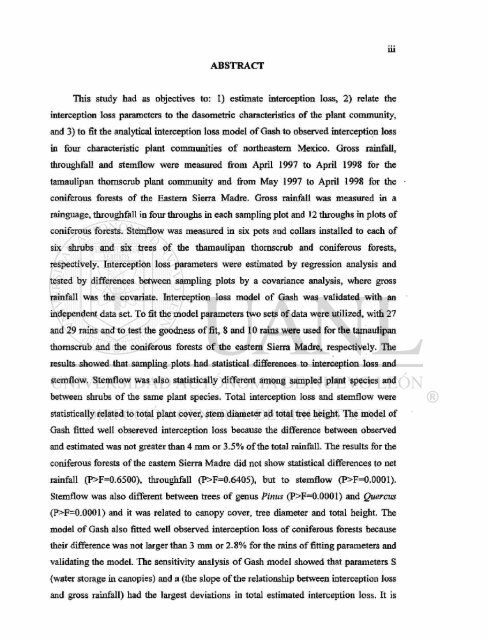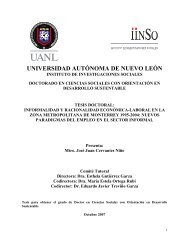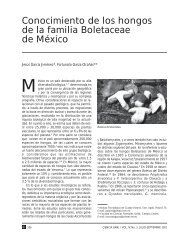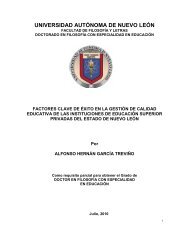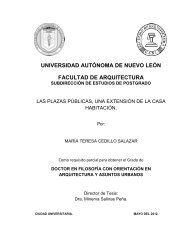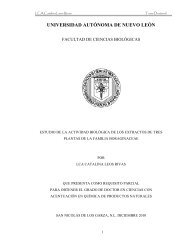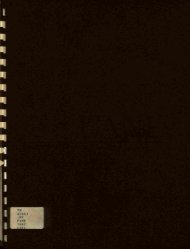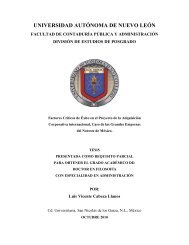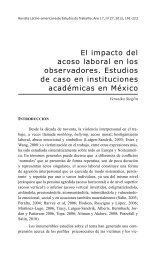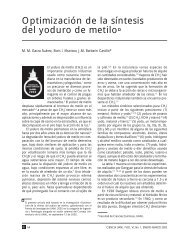Download (14Mb) - Universidad Autónoma de Nuevo León
Download (14Mb) - Universidad Autónoma de Nuevo León
Download (14Mb) - Universidad Autónoma de Nuevo León
Create successful ePaper yourself
Turn your PDF publications into a flip-book with our unique Google optimized e-Paper software.
This study had as objectives to: 1) estimate interception loss, 2) relate the<br />
interception loss parameters to the dasometric characteristics of the plant community,<br />
and 3) to fît the analytical interception loss mo<strong>de</strong>l of Gash to observed interception loss<br />
in four characteristic plant communities of northeastern Mexico. Gross rainfall,<br />
throughfall and stemflow were measured from April 1997 to April 1998 for the<br />
tamaulipan thornscrub plant community and from May 1997 to April 1998 for the<br />
coniferous forests of the Eastern Sierra Madre. Gross rainfall was measured in a<br />
rainguage, throughfall in four throughs in each sampling plot and 12 throughs in plots of<br />
coniferous forests. Stemflow was measured in six pots and collars installed to each of<br />
six shrubs and six trees of the thamaulipan thornscrub and coniferous forests,<br />
respectively. Interception loss parameters were estimated by regression analysis and<br />
tested by differences between sampling plots by a covariance analysis, where gross<br />
rainfall was the covariate. Interception loss mo<strong>de</strong>l of Gash was validated with an<br />
in<strong>de</strong>pen<strong>de</strong>nt data set. To fit the mo<strong>de</strong>l parameters two sets of data were utilized, with 27<br />
and 29 rains and to test the goodness of fit, 8 and 10 rains were used for the tamaulipan<br />
thornscrub and the coniferous forests of the eastern Sierra Madre, respectively. The<br />
results showed that sampling plots had statistical differences to interception loss and<br />
stemflow. Stemflow was also statistically different among sampled plant species and<br />
between shrubs of the same plant species. Total interception loss and stemflow were<br />
statistically related to total plant cover, stem diameter ad total tree height. The mo<strong>de</strong>l of<br />
Gash fitted well obsereved interception loss because the difference between observed<br />
and estimated was not greater than 4 mm or 3.5% of the total rainfall. The results for the<br />
coniferous forests of the eastern Sierra Madre did not show statistical differences to net<br />
rainfall (P>F=0.6500), throughfall (P>F=0.6405), but to stemflow (P>F=0.0001).<br />
Stemflow was also different between trees of genus Pinus (P>F=0.0001) and Quercus<br />
(P>F=0.0001) and it was related to canopy cover, tree diameter and total height. The<br />
mo<strong>de</strong>l of Gash also fitted well observed interception loss of coniferous forests because<br />
their difference was not larger than 3 mm or 2.8% for the rains of fitting parameters and<br />
validating the mo<strong>de</strong>l. The sensitivity analysis of Gash mo<strong>de</strong>l showed that parameters S<br />
(water storage in canopies) and a (the slope of the relationship between interception loss<br />
and gross rainfall) had the largest <strong>de</strong>viations in total estimated interception loss. It is


